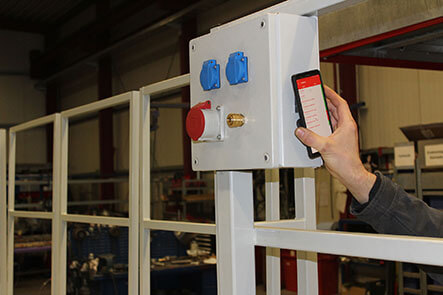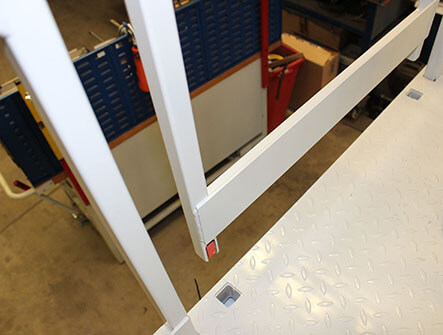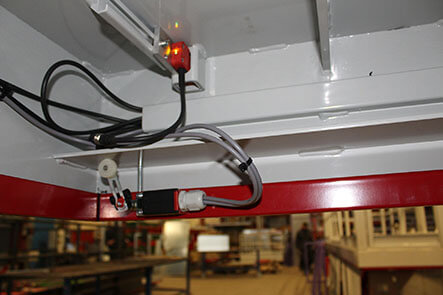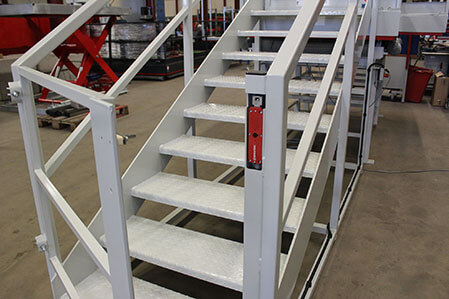"Lifting heavy things easily" - Janzen Lifttechnik has made this credo its own. The company from the far north in Niederlangen builds customised hydraulic lifting tables, lifts and aerial work platforms for its customers. Particularly when it comes to transporting people, high demands are placed on occupational safety. The company has found a reliable partner for the realisation of reliable safety technology in BERNSTEIN - in the case of a current project, even particularly SMART.
"The requirement of our customers is quickly explained," Stefan Winter (Janzen Lifttechnik) makes clear. "They want a solution that is as inexpensive as possible in order to be able to transport as much weight as possible, as high as possible." For a current customer project, three aerial work platforms of different sizes and payloads were completed. The transport of people is also an issue here, which according to the valid standard for safety requirements for lifting tables (EN1570-1) requires a particularly high safety standard.
Janzen Lifttechnik works together with BERNSTEIN AG from Porta Westfalica to implement this demanding requirement for safety technology. The company's product portfolio ranges from switches, sensors and enclosures to support systems and operating terminals to system solutions for operating and safeguarding entire machines and systems.
In concrete terms, several components are used to ensure safety on the lifting platforms. On the working platform itself, six push-in railings and two self-closing doors provide fall protection during a lifting or lowering operation. Once at the top or bottom, the railings can be removed to access a hard-to-reach work area. The railings and doors are monitored by the SRF (Safety RFID) non-contact safety sensor. The SRF secures the doors and plug-in railings by not allowing the lift to move up or down in the first place until these separating protective devices are properly locked, i.e. the railings have not been properly anchored.
In contrast to a mechanical position switch, for example, the sensor does not allow any manipulation: "The SRF offers no possibility to bypass the protective measure. As long as the railings are not properly inserted, the lift cannot be moved," explains Robert Thesing from BERNSTEIN, who is the contact person on site for Janzen Lifttechnik.
"When a worker is standing on the working platform and notices at the top position that the platform cannot be moved, then a time-consuming troubleshooting began up to now. He had to check every plug-in railing and every door, every single safety device. Depending on how big the platform is, this can take several minutes." Robert Thesing describes further. The SRF safety sensor counteracts this effort. During development, BERNSTEIN placed special focus on the diagnostic system that goes with the sensor: It reads out a large amount of data and makes it available centrally and flexibly. The diagnostic data is displayed on the smartphone via NFC technology, for example. A function that Janzen Lifttechnik also uses. "If the platform does not move, the person on the working platform reads out the data via NFC interface and immediately learns which SRF sensor is reporting a problem. The corresponding railing can be checked without detours and quickly closed again correctly."
"We have already worked with BERNSTEIN on a previous project and were able to gain experience with the SRF safety sensor. It is exactly the right one for our requirements because, on the one hand, it is suitable for outdoor use. On the other hand, working with non-contact safety technology offers advantages for many applications. Malfunctions due to dirt, for example, are not an issue here, nor is manipulation. The fact that we can obtain different safety solutions from a single source and scale them according to requirements also influenced our decision," says Stefan Winter, explaining the reasons for working with BERNSTEIN.
In addition to the SRF, the aforementioned lifting platforms from Janzen Lifttechnik also use the SLC (Safety Lock) guard locking on the access door of a staircase leading to the platform. As soon as the lifting platform moves, it must be ensured that the door to the staircase can no longer be opened and that other persons remain outside the danger zone.
This task is performed by the SLC interlocking switch from BERNSTEIN. It is a hybrid solution of metal and plastic components. All mechanically stressed components are made entirely of metal, which makes it particularly robust - a useful feature when used in an access door that is primarily intended to be functional and is not handled gently during operation. The less stre



